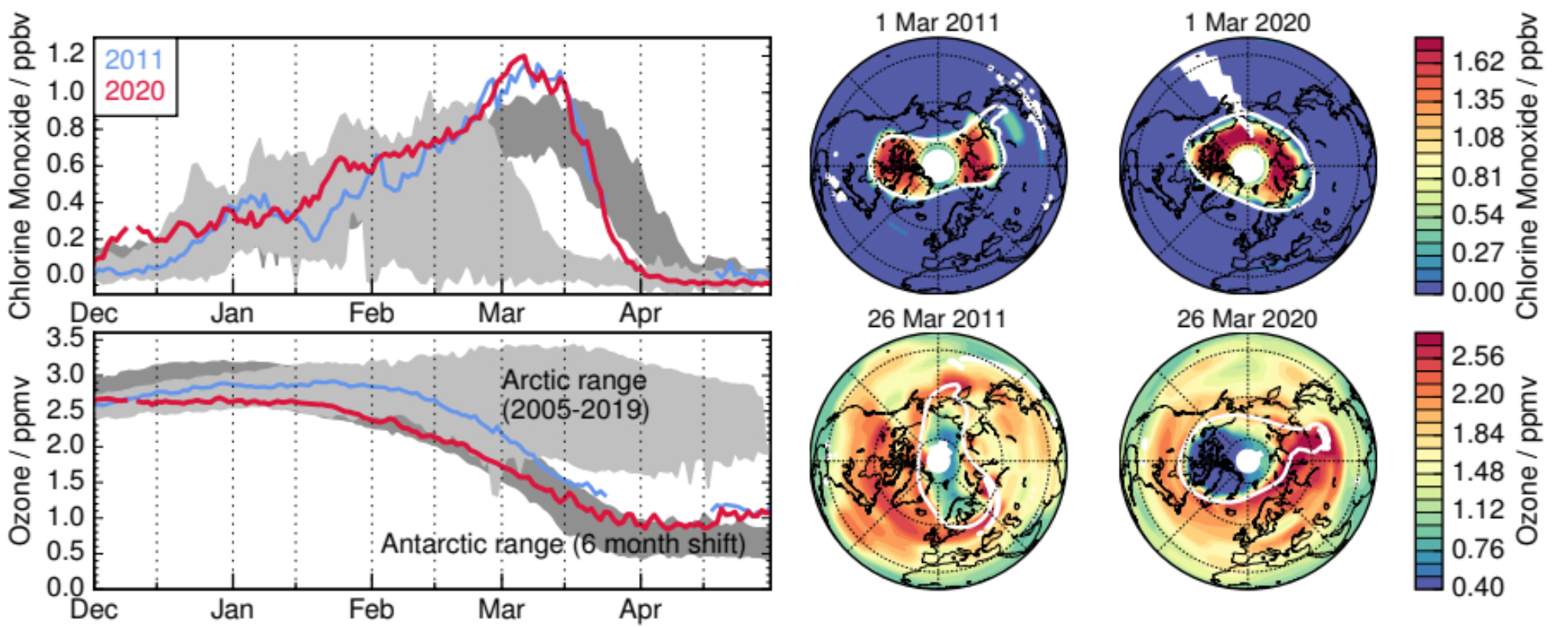The 2019/2020 Arctic stratospheric polar vortex was exceptionally strong, cold, and persistent, setting a new record for conditions most conducive to Arctic chemical ozone destruction. Microwave Limb Sounder (MLS) composition measurements show how these conditions led to record-low Arctic ozone in spring 2020. Extremely large interannual variability in Arctic stratospheric meteorological conditions, coupled with climate change effects that tend to make colder stratospheric winters more likely, means that, even as stratosphere chlorine levels begin to decline, springtime Arctic ozone values may be expected in the future that are as low as or lower than those in 2020, with potential human/biological impacts from resultant increases in surface ultraviolet radiation. Comprehensive composition measurements such as those from MLS, including not only ozone, but also chlorine and other species needed to quantify chemical processes affecting ozone, are critical to understanding and tracking future extremes in Arctic stratospheric ozone.

Left: Red lines show 2019/2020 MLS observations of Arctic vortex-average chlorine monoxide (ClO, upper), both a marker and an agent of chemical ozone destruction, and ozone itself (lower) at about 17 km altitude (460 K potential temperature). Blue lines show 2010/2011, the previous record holder. Pale grey shading is the 2004-2018 range; darker grey shading is the Antarctic range (shifted by six months). Right: Maps compare selected days in the Arctic in 2011 and 2020. White lines mark the polar vortex - the region within which ozone destruction is confined.
Technical description of figure:
(Left) Vortex-averaged chlorine monoxide (ClO, upper) and ozone (lower) on the 460-K isentropic surface (~17 km) from MLS Level-3 data for 2010/2011 (blue) and 2019/2020 (red). Light grey envelopes show the range of Arctic values in the 2004/2005 through 2018/2019 winters excluding the two highlighted years. Dark grey envelopes show the range of Antarctic values for 2005 through 2019, shifted six months to show the same season. Arctic ClO (the primary active form of chlorine that destroys ozone) declined to near-zero values 2–3 weeks later in 2011 and 2020 than in any other Arctic winter observed by Aura MLS, and only days earlier than the earliest years in the MLS Antarctic record. While ozone declined at similar rates in February and March in the two years highlighted, it began to decline earlier in 2019/2020 than in 2010/2011, leading to the lowest Arctic ozone values on record. (Right) Maps of MLS ClO on 1 March (upper) and ozone on 26 March in 2011 and 2020, with white overlays showing a potential vorticity value (from MERRA-2) representative of the vortex edge; these show similar maximum ClO values in the two years, and a larger vortex with lower ozone values in late March 2020 than at the same time in 2011.
Data Sources:
References: Manney, G.L., Livesey, N.J., Santee, M.L., Froidevaux, L., Lambert, A., Lawrence, Z.D., Millán, L.F., Neu, J.L., Read, W.G., Schwartz, M.J., and Fuller, R.A. (2020). Record‐low Arctic stratospheric ozone in 2020: MLS observations of chemical processes and comparisons with previous extreme winters. Geophysical Research Letters, 47, e2020GL089063. https://doi.org/10.1029/2020GL089063.
11.2020